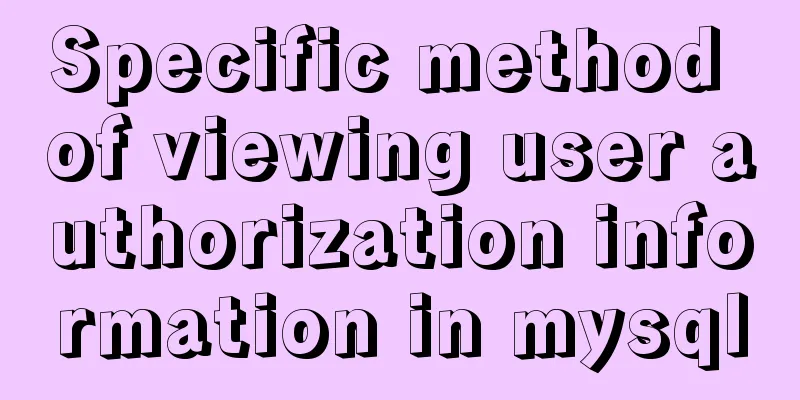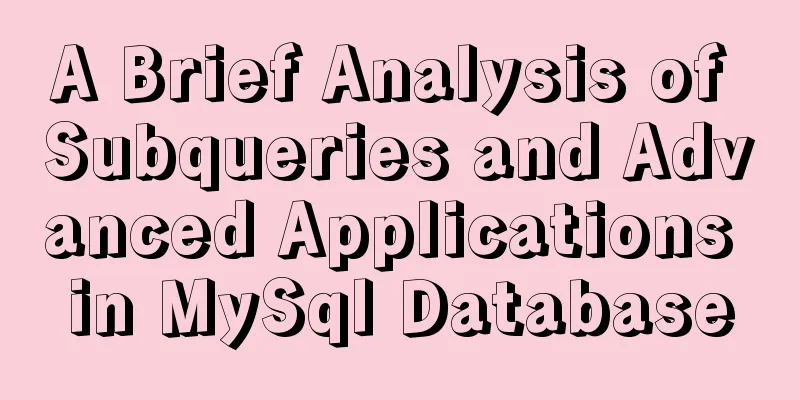Specific method of viewing user authorization information in mysql

|
Specific method: 1. Open Command Prompt 2. Enter the mysql -u root -p command and press Enter 3. Enter the correct password and enter the mysql command line 4. View user authorization information SHOW GRANTS FOR 'root'@'localhost'; Check the authorization information for the user name root and the host name localhost. Knowledge point expansion: MySQL View the permissions granted by the user In MySQL, how do you view the permissions a user has been granted? The permissions granted to users may be divided into global-level permissions, database-level permissions, table-level permissions, column-level permissions, and subroutine-level permissions. The specific categories are as follows: Global Level Global privileges apply to all databases in a given server. These permissions are stored in the mysql.user table. GRANT ALL ON *.* and REVOKE ALL ON *.* grant and revoke only global privileges. Database level Database privileges apply to all objects in a given database. These permissions are stored in the mysql.db and mysql.host tables. GRANT ALL ON db_name.* and REVOKE ALL ON db_name.* grant and revoke database privileges only. Table Level Table privileges apply to all columns in a given table. These privileges are stored in the mysql.tables_priv table. GRANT ALL ON db_name.tbl_name and REVOKE ALL ON db_name.tbl_name grant and revoke table privileges only. Column level Column permissions apply to a single column in a given table. These privileges are stored in the mysql.columns_priv table. When using REVOKE, you must specify the same columns as those being granted. Subroutine level CREATE ROUTINE, ALTER ROUTINE, EXECUTE, and GRANT privileges apply to stored routines. These privileges can be granted at the global level or at the database level. Also, except CREATE ROUTINE, these privileges can be granted at the subprogram level and are stored in the mysql.procs_priv table. The above is the detailed content of the specific method of viewing user authorization information in MySQL. For more information on how to view user authorization information in MySQL, please pay attention to other related articles on 123WORDPRESS.COM! You may also be interested in:
|
<<: Some data processing methods that may be commonly used in JS
>>: How to use fdisk to partition disk in Linux
Recommend
Solve the problem of MySQL reporting Invalid default value for ''operate_time'' error
Execute the create table statement in the databas...
LayUI+Shiro implements a dynamic menu and remembers the example of menu expansion
Table of contents 1. Maven Dependency 2. Menu rel...
How to hide the version number and web page cache time in Nginx
Nginx optimization---hiding version number and we...
How to implement html input drop-down menu
Copy code The code is as follows: <html> &l...
Writing High-Quality Code Web Front-End Development Practice Book Excerpts
(P4) Web standards are composed of a series of sta...
Docker installation of Nginx problems and error analysis
question: The following error occurred when insta...
A brief analysis of the knowledge points of exporting and importing MySQL data
Often, we may need to export local database data ...
MySQL 5.7 mysql command line client usage command details
MySQL 5.7 MySQL command line client using command...
Docker enables seamless calling of shell commands between container and host
As shown below: nsenter -t 1 -m -u -n -i sh -c &q...
Specific use of Linux which command
We often want to find a file in Linux, but we don...
Summary of WEBAPP development skills (notes for mobile website development)
1. To develop web responsively, the page must ada...
Detailed explanation of Axios asynchronous communication in Vue
1. First, we create a .json file for interactive ...
Detailed explanation of MYSQL database table structure optimization method
This article uses an example to illustrate the me...
MySQL 8.0.3 RC is about to be released. Let’s take a look at the changes
MySQL 8.0.3 is about to be released. Let’s take a...
Methods and techniques for quickly displaying web page images
1. Use .gifs rather than .jpgs. GIFs are smaller ...









